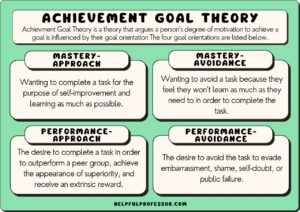Adhering to a Social Constructivist lens, Achievement Goal Theory supports motivational foundations that student beliefs surrounding task-involvement and goal-mastery ultimately predict probabilities of success. Through four facets of achievement: Performance-Approach, Performance-Avoidance, Mastery-Approach and Mastery-Avoidance, Elliot (2017) and others demonstrate the dichotomy between “learning for success,” and “learning to avoid failure.”

These two diametrically opposed ideas: success and failure, resonate in the interactions between countless students and educators everyday. By understanding why some students strive to meet pre-determined goals, some work for content mastery, and others work simply not to fail or look incompetent, it has allowed me a different perspective on trying to connect with individual students and their varying motivations, or lack thereof.
Finally, by using the TARGET acronym included in this artifact, it has allowed me to develop a different perspective of how to connect to, and include developmentally appropriate and student-centric approaches to developing student “competence” in a wide vary of subject matter.
